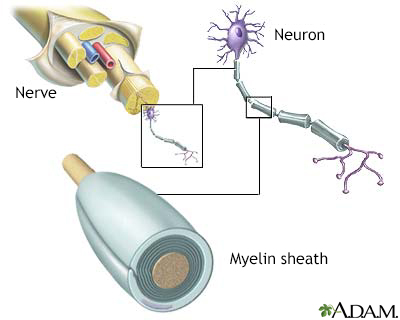Pregnancy SmartSiteTM
MS; Demyelinating disease DefinitionMultiple sclerosis (MS) is an autoimmune disease that affects the brain and spinal cord (central nervous system). CausesMS affects women more often than men. The disorder is most commonly diagnosed between ages 20 to 40, but it can be seen at any age. MS is caused by damage to the myelin sheath. This sheath is the protective covering that surrounds nerve cells. When this nerve covering is damaged, nerve signals slow or stop. The nerve damage is caused by inflammation. Inflammation occurs when the body's immune cells attack the nervous system. This can occur along any area of the brain, optic nerve, and spinal cord. It is unknown what exactly causes MS. The most common thought is that it is caused by a virus, a gene defect, or both. Environmental factors may also play a role. You are slightly more likely to develop this condition if you have a family history of MS or you live in a part of the world where MS is more common (areas further from the equator). SymptomsSymptoms vary because the location and severity of each attack can be different. Attacks can last for days, weeks, or months. Attacks are followed by remissions. These are periods of reduced symptoms or no symptoms. Fever, hot baths, sun exposure, and stress can trigger or worsen attacks. Nerves in any part of the brain or spinal cord may be damaged. Because of this, MS symptoms can appear in many parts of the body. Muscle symptoms:
Bowel and bladder symptoms:
Eye symptoms:
Numbness, tingling, or pain:
Other brain and nerve symptoms:
Sexual symptoms:
Speech and swallowing symptoms:
Fatigue is a common and bothersome symptom as MS progresses. It is often worse in the late afternoon. Exams and TestsSymptoms of MS may mimic those of many other nervous system problems. MS is diagnosed by determining if there are signs of more than one attack on the brain or spinal cord and by ruling out other conditions. People who have a form of MS called relapsing-remitting MS have evidence of at least two attacks separated by a remission. In other people, the disease may slowly get worse in between clear attacks. This form is called secondary progressive MS. A form with gradual progression, but no clear attacks is called primary progressive MS. Your health care provider may suspect MS if there are decreases in the function of two different parts of the central nervous system (such as abnormal reflexes) at two different times. An exam of the nervous system may show reduced nerve function in one area of the body. Or the reduced nerve function may be spread over many parts of the body. This may include:
An eye exam may show:
Tests to diagnose MS include:
TreatmentThere is no known cure for MS at this time, but there are treatments that may slow the disease. The goal of treatment is to stop progression, control symptoms, and help you maintain a normal quality of life. Medicines are often taken long-term. These include:
Medicines are more effective for the relapsing-remitting form than for other forms of MS. The following may also be helpful for people with MS:
Support GroupsLiving with MS may be a challenge. You can ease the stress of illness by joining an MS support group. Sharing with others who have common experiences and problems can help you not feel alone. Outlook (Prognosis)The outcome varies, and is hard to predict. Although the disorder is life-long (chronic) and incurable, life expectancy can be normal or almost normal. Most people with MS are active and function at work with little disability. Those who usually have the best outlook are:
The amount of disability and discomfort depends on:
Most people return to normal or near-normal function between attacks. Over time, there is greater loss of function with less improvement between attacks. Possible ComplicationsMS may lead to the following:
When to Contact a Medical ProfessionalContact your provider if:
ReferencesCalabresi PA, Multiple sclerosis and demyelinating conditions of the central nervous system. In: Goldman L, Cooney KA, eds. Goldman-Cecil Medicine. 27th ed. Philadelphia, PA: Elsevier; 2024:chap 380. Fabian MT, Krieger SC, Lublin FD. Multiple sclerosis and other inflammatory demyelinating diseases of the central nervous system. In: Jankovic J, Mazziotta JC, Pomeroy SL, Newman NJ, eds. Bradley and Daroff's Neurology in Clinical Practice. 8th ed. Philadelphia, PA: Elsevier; 2022:chap 80. Rae-Grant A, Day GS, Marrie RA, et al. Practice guideline recommendations summary: disease-modifying therapies for adults with multiple sclerosis: report of the Guideline Development, Dissemination, and Implementation Subcommittee of the American Academy of Neurology. Neurology. 2018;90(17):777-788. PMID: 29686116 pubmed.ncbi.nlm.nih.gov/29686116/. | ||
| ||
Review Date: 3/31/2024 Reviewed By: Joseph V. Campellone, MD, Department of Neurology, Cooper Medical School at Rowan University, Camden, NJ. Review provided by VeriMed Healthcare Network. Also reviewed by David C. Dugdale, MD, Medical Director, Brenda Conaway, Editorial Director, and the A.D.A.M. Editorial team. View References The information provided herein should not be used during any medical emergency or for the diagnosis or treatment of any medical condition. A licensed medical professional should be consulted for diagnosis and treatment of any and all medical conditions. Links to other sites are provided for information only -- they do not constitute endorsements of those other sites. No warranty of any kind, either expressed or implied, is made as to the accuracy, reliability, timeliness, or correctness of any translations made by a third-party service of the information provided herein into any other language. © 1997- A.D.A.M., a business unit of Ebix, Inc. Any duplication or distribution of the information contained herein is strictly prohibited. | ||


 Multiple sclerosis
Multiple sclerosis MRI of the brain
MRI of the brain Central nervous sy...
Central nervous sy... Myelin and nerve s...
Myelin and nerve s... Nerve supply to th...
Nerve supply to th...
